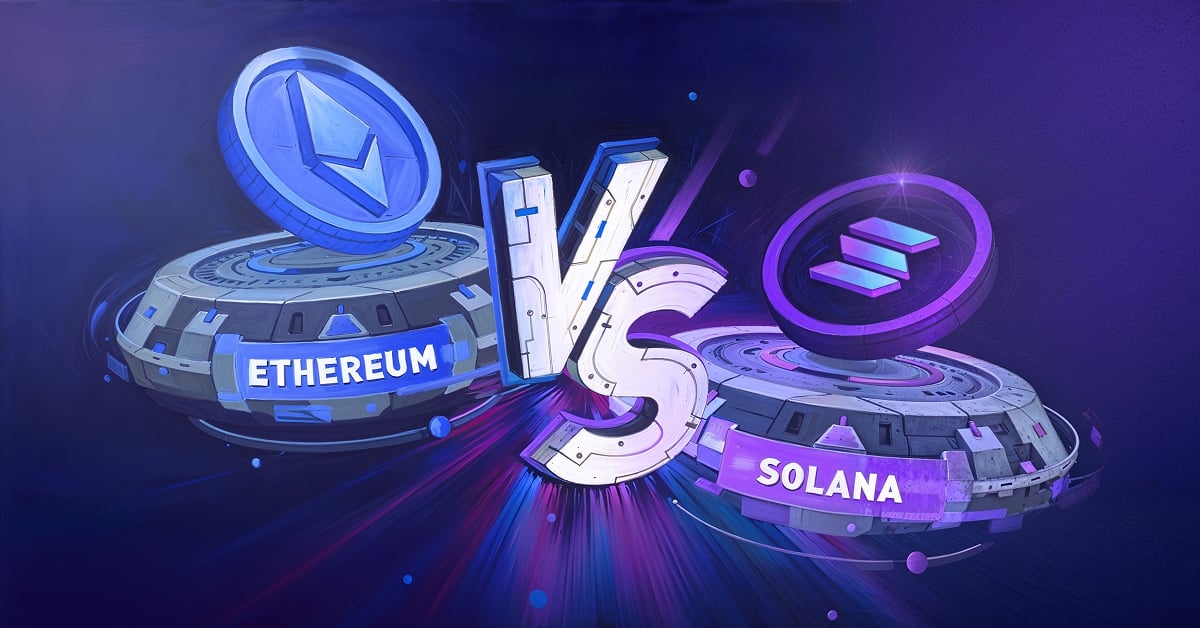Are you curious about which blockchain is best for your dApp, Ethereum or Solana?
Both are super popular, but they work in different ways and offer unique benefits. Ethereum is like the “OG” of smart contracts. It’s been around longer, has a huge community, and is known for its strong security.
On the other hand, Solana is the fast and fresh challenger. It’s built for speed and low fees, which can be awesome for games and apps that need quick actions.
Key takeaways:
-
- Ethereum offers strong decentralization, security, and a mature ecosystem, making it ideal for enterprise-grade and long-term decentralized application development.
- Solana provides ultra-fast transaction speeds and minimal fees, making it better suited for real-time, high-throughput dApps like games and microtransaction platforms.
- Ethereum’s vast developer community and tooling ecosystem help teams build robust, scalable solutions with support from countless open-source libraries and resources.
- Solana’s mobile-first strategy and growing ecosystem attract developers focused on innovation, speed, and efficient user experiences for modern decentralized apps.
As more developers create decentralized apps, choosing the right platform is a big decision.
In this blog, we’ll explore how Ethereum vs Solana for dApps compare in terms of speed, cost, security, and community support.
Whether you’re building a game, a finance app, or something totally new, this guide will help you understand which blockchain could be the better fit for your big idea.
Let’s dive in!
What Is Ethereum?
Ethereum is the best blockchain for dApp development, allowing developers to build and run smart contracts and decentralized applications (dApps). Launched in 2015, it uses a secure, open-source network and has recently upgraded to Proof of Stake for better energy efficiency.
Known for its large developer community and strong security, Ethereum supports many popular dApps in finance, gaming, and NFTs, making it one of the most trusted platforms in the blockchain world.
History and Background of Ethereum
Ethereum was proposed in 2013 by Vitalik Buterin, a young programmer who wanted to expand blockchain beyond just digital money. It officially launched in 2015 with the goal of creating a decentralized platform for smart contracts and dApps.
Bonus Read: What is Blockchain App Development
Unlike Bitcoin, Ethereum was designed to be programmable. Over time, it gained massive developer support and became the foundation for many innovations like DeFi, NFTs, and DAOs in the blockchain space.
10 Key Features of Ethereum
Ethereum is one of the most popular blockchain systems in the world, and it stands out for its tremendous features. Here are ten fundamental aspects that make Ethereum unique:
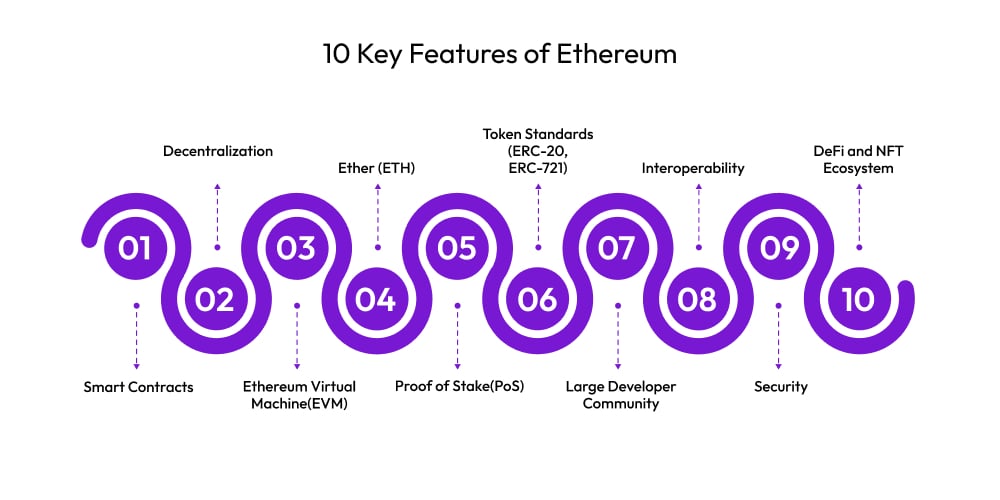
-
Smart Contracts
Ethereum introduced smart contracts, which are self-executing programs that operate exactly as coded. They eliminate the need for middlemen in digital agreements.
-
Decentralization
Ethereum is not governed by a single authority. Thousands of nodes throughout the world validate transactions, ensuring that the network is safe and resistant to censorship.
-
Ethereum Virtual Machine(EVM)
The EVM allows anybody to deploy programs written in a variety of programming languages. It functions as a global computer for executing smart contracts.
-
Ether (ETH)
Ether is Ethereum’s native coin. It is used to pay transaction fees (gas) as well as to trade and stake digital assets.
- Proof of Stake(PoS)
Ethereum 2.0 replaced Proof of Work with Proof of Stake (PoS). This improves the network’s energy efficiency and scalability.
-
Token Standards (ERC-20, ERC-721)
Ethereum allows users to create tokens. Fungible tokens utilize ERC-20, whereas non-fungible tokens use ERC-721.
-
Large Developer Community
Ethereum is the largest community of blockchain developers, who are continually upgrading the platform and creating new dApps.
-
Interoperability
Ethereum provides several tools and bridges for connecting with other blockchains, boosting its use cases.
-
Security
Ethereum is well-known as one of the most secure smart contract systems, thanks to its solid track record and regular improvements.
-
DeFi and NFT Ecosystem
Most DeFi protocols and NFTs were initially based on Ethereum, making it the foundation of the Web3 economy.
5 Use Cases of Ethereum
Explore the top use cases of Ethereum, including DeFi, NFTs, smart contracts, dApps, and stablecoin payments. Ethereum’s versatile blockchain powers secure, decentralized solutions across finance, gaming, digital art, and more, redefining how we interact with technology and value.
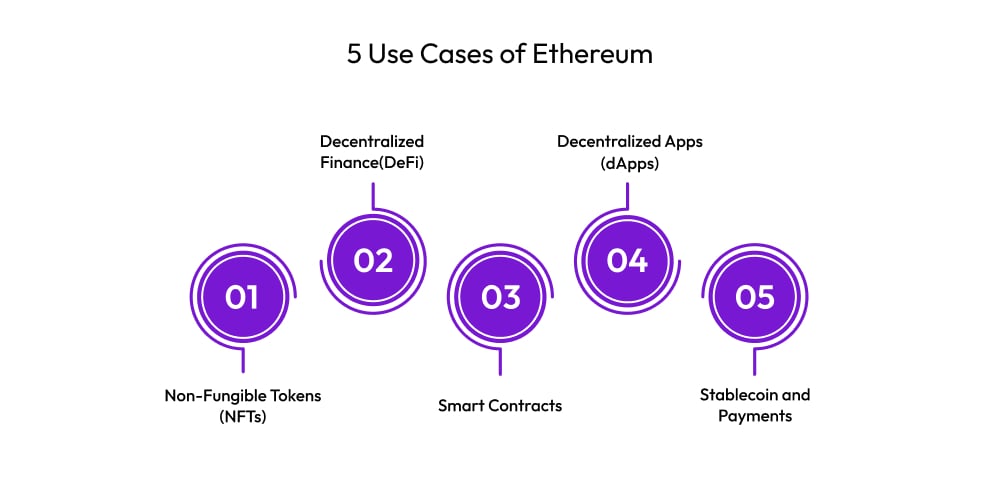
1. Non-Fungible Tokens (NFTs)
Ethereum is the dominant platform for NFTs, which are unique digital assets that represent art, music, collectibles, and other items. Artists can create NFTs on platforms such as OpenSea to provide proof of ownership and authenticity.
With the help of an NFT development company, these tokens are kept on the blockchain and may be purchased, sold, or exchanged worldwide.
2. Decentralized Finance(DeFi)
Ethereum enables a wide range of DeFi applications, including lending, borrowing, and trading without banks. Platforms like as Aave and Uniswap employ smart contracts to automate financial services, giving consumers more control, transparency, and access to global financial systems—all without the need for traditional middlemen.
3. Smart Contracts
Smart contract compatibility is a self-executing agreement with preset rules that operate on the Ethereum blockchain. They are utilized in a variety of businesses, including real estate, insurance, and gambling, to automate procedures, cut costs, and prevent fraud.
According to the Ethereum development company, they cannot be modified, assuring user confidence and transparency.
4. Decentralized Apps (dApps)
Ethereum enables hundreds of dApps in banking, gaming, identification, and government. These apps are decentralized and use Ethereum’s blockchain to perform logic and securely store data. Examples are Compound for banking and Axie Infinity for gaming.
5. Stablecoin and Payments
Ethereum supports popular stablecoins like as USDT and USDC, which are tied to fiat currencies. These are used for worldwide payments, remittances, and savings, all with the added speed and security of blockchain technology. Ethereum’s network offers quick, low-cost, borderless transactions that are transparent.
Interested in a chatbot demo, pricing, or more info? Fill out the form our expert will contact you shortly.
-
Chatbot Demo
-
Cost to Develop an app
-
Industry Report
-
Case Study
Popular dApps Built on Ethereum
Discover the top decentralized applications (dApps) built on Ethereum, from NFT marketplaces like OpenSea to DeFi platforms like Uniswap and Aave. Learn how these innovative dApps are transforming digital finance, virtual worlds, and blockchain-based experiences.
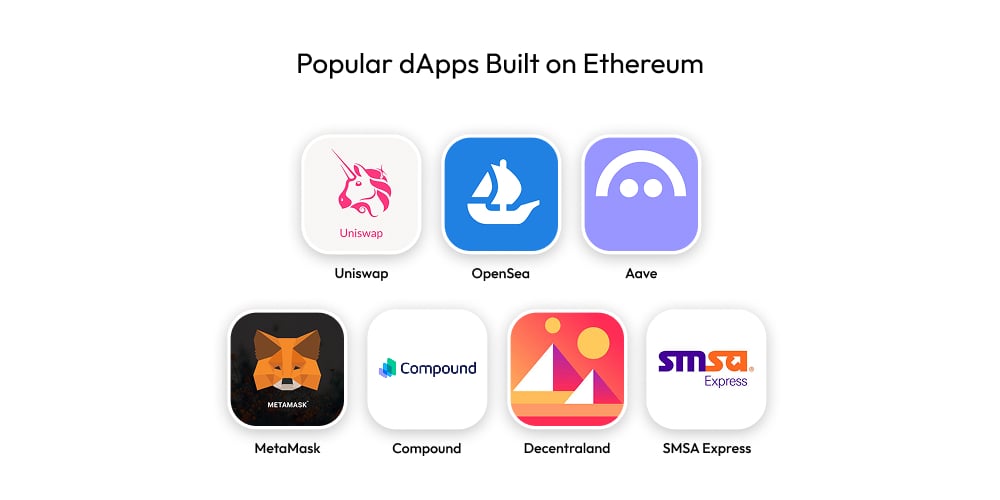
1. Uniswap
Uniswap is a decentralized exchange (DEX) that allows users to swap Ethereum-based tokens without relying on a central authority. It sets prices using an automated market maker (AMM) approach and smart contract performance.
Uniswap is one of the most popular DeFi platforms, providing quick, permissionless trading without the need for an account or KYC.
2. OpenSea
OpenSea is the largest NFT marketplace based on Ethereum. It enables users to produce, purchase, and trade non-fungible tokens like as digital art, collectibles, and in-game stuff.
Artists and collectors use it to display and exchange their NFTs. With a simple interface and widespread backing, it has emerged as a hub for the developing NFT economy.
3. Aave
Aave is a decentralized lending system that enables users to earn interest on cryptocurrency deposits while borrowing assets quickly. It supports a wide range of coins and employs overcollateralization to mitigate risk.
Users can choose between fixed and variable interest rates. Aave, which is built on Ethereum, aims to make finance more transparent and accessible to everyone.
4. MetaMask
MetaMask is a cryptocurrency wallet and browser plugin that allows users to access the Ethereum network. It securely saves private keys, manages ETH and tokens, and enables seamless interaction with dApps directly through the browser.
For businesses looking to build or integrate similar solutions, partnering with a reliable cryptocurrency development company can ensure secure, scalable, and customized blockchain experiences.
5. Compound
Compound is a decentralized finance (DeFi) platform where users may lend and borrow Ethereum-based assets. Lenders gain interest, while borrowers submit collateral to obtain loans.
Interest rates vary naturally according to supply and demand. Compound, which is entirely powered by smart contracts, allows customers greater control over their funds by eliminating the need for banks.
6. Decentraland
Decentraland is a virtual world based on Ethereum in which users may purchase land, create scenes, and explore a digital cosmos. Land is held using NFTs, and transactions are conducted using the in-game money, MANA. It is a pioneer of blockchain-based metaverses, combining games, real estate, and social interaction in a completely decentralized manner.
7. MakerDAO
MakerDAO is the system that powers DAI, Ethereum’s decentralized stablecoin. It enables users to save cryptocurrency as collateral and create DAI, which is tethered to the US dollar. MakerDAO maintains DAI’s value using smart contracts and is overseen by MKR token holders, who vote on system improvements.
What is Solana?
Solana is a high-performance blockchain platform designed for fast, low-cost decentralized applications (dApps). Launched in 2020, it uses a unique Proof of History (PoH) system combined with Proof of Stake (PoS) to achieve high speeds and scalability.
Solana can handle thousands of transactions per second with very low fees, making it ideal for gaming, DeFi, and NFTs. It’s known for speed, affordability, and growing developer adoption.
History and Background of Solana
Solana was founded in 2017 by Anatoly Yakovenko, a former Qualcomm engineer, and officially launched in 2020. It was created to solve blockchain scalability issues using a new concept called Proof of History (PoH), which timestamps transactions for faster processing.
Bonus Read: How Dapps Work
Backed by strong venture support, Solana quickly gained popularity for its high speed and low fees, becoming a major platform for DeFi, NFTs, and Web3 applications.
10 Key Features of Solana
Solana is a fast and blockchain platform scalability that enables decentralized applications (dApps) with minimal fees and great throughput. Here are 10 crucial Solana network features:
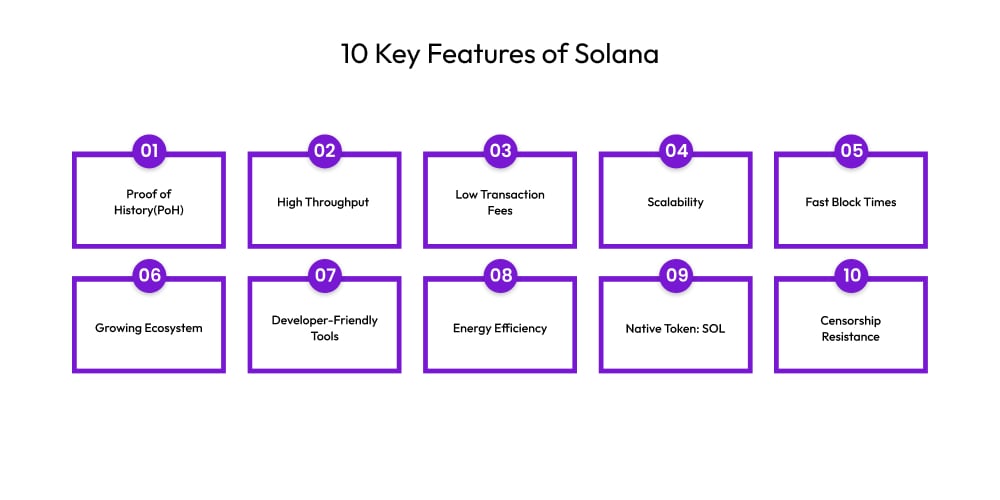
-
Proof of History(PoH)
Solana employs a novel consensus approach called Proof of History, which timestamps transactions before they are executed. This improves the speed and efficiency of the network.
-
High Throughput
Solana can process more than 65,000 transactions per second (TPS), making it one of the quickest blockchains available. It’s intended for widespread adoption and high-volume dApps.
-
Low Transaction Fees
One of Solana’s main features is its extremely cheap transaction fees, often less than $0.01 per transaction, which makes it perfect for micropayments and high-frequency trading.
-
Scalability
Solana scales organically as technology improves and does not rely on Layer 2 solutions, allowing it to handle more consumption without sacrificing performance.
-
Fast Block Times
Solana’s block time is about 400 milliseconds, which implies that transactions are verified in less than a second, ideal for real-time applications.
-
Growing Ecosystem
Solana has swiftly built a robust ecosystem of DeFi platforms, NFT projects, games, and tools, establishing itself as a competitive developer hub.
-
Developer-Friendly Tools
It provides tools and SDKs that make it easier for developers to create and deploy dApps.
-
Energy Efficiency
Because of PoH and PoS, Solana uses considerably less energy than standard Proof of Work blockchains.
-
Native Token: SOL
SOL is used to pay fees, stake assets, and participate in governance.
-
Censorship Resistance
Solana’s hundreds of validators create a decentralized and secure network that is resistant to control and censorship.
5 Use Cases of Solana
Discover unique use cases of Solana beyond DeFi and NFTs, including blockchain gaming, move-to-earn fitness apps, decentralized identity, social media platforms, and supply chain tracking. Solana’s speed and scalability enable innovative solutions across diverse industries.
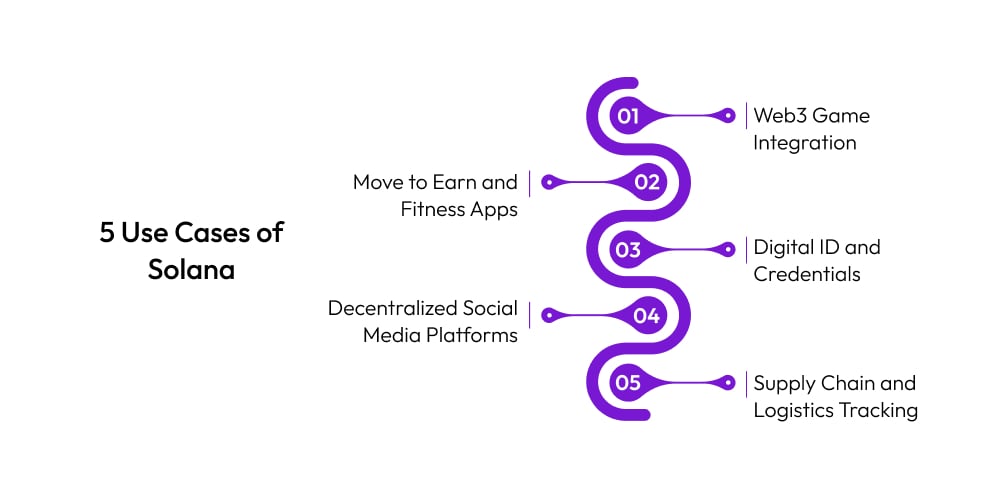
1. Web3 Game Integration
Solana supports immersive real-time blockchain games such as Star Atlas and Aurory. Its lightning-fast processing power facilitates sophisticated visuals, asset ownership, and in-game economics.
Bonus Read: Public vs Private Blockchain
Players may own and exchange assets like NFTs, earn prizes, and enjoy low-latency gameplay, making Solana perfect for creating next-generation metaverse and multiplayer experiences.
2. Move to Earn and Fitness Apps
Apps such as StepN employ Solana to reward physical exercise with cryptocurrency. Users earn tokens while walking, jogging, or running, integrating fitness with blockchain.
This move-to-earn approach generates real-world value from healthy habits and depends on Solana’s scalability and speed to provide seamless tracking and immediate incentives.
3. Digital ID and Credentials
Solana may be used to create decentralized identification (DID) systems that provide users control over their personal data and safe access to services.
Blockchain benefits for business-verified credentials may be used in healthcare, education, and recruiting, decreasing fraud and removing the need for centralized verification all while protecting data privacy and ownership.
4. Decentralized Social Media Platforms
Audius and Grape Protocol are utilizing Solana to build social networks and content-sharing platforms that directly compensate authors.
These systems decrease censorship, promote token-based participation, and empower users to own their content and communities, providing a decentralized alternative to standard social applications.
5. Supply Chain and Logistics Tracking
The Solana blockchain can trace items via complicated supply networks in real time. Companies may increase transparency, avoid fraud, and verify product authenticity by recording every stage of the manufacturing and distribution processes. Its rapid and low-cost structure makes it a viable option for enterprise-grade supply chain solutions.
Popular dApps Built on Solana
Discover the most popular dApps built on Solana, including Phantom, Magic Eden, Raydium, and StepN. These fast, low-cost applications are transforming DeFi, NFTs, and Web3 experiences with high performance, user-friendly design, and innovative blockchain features.
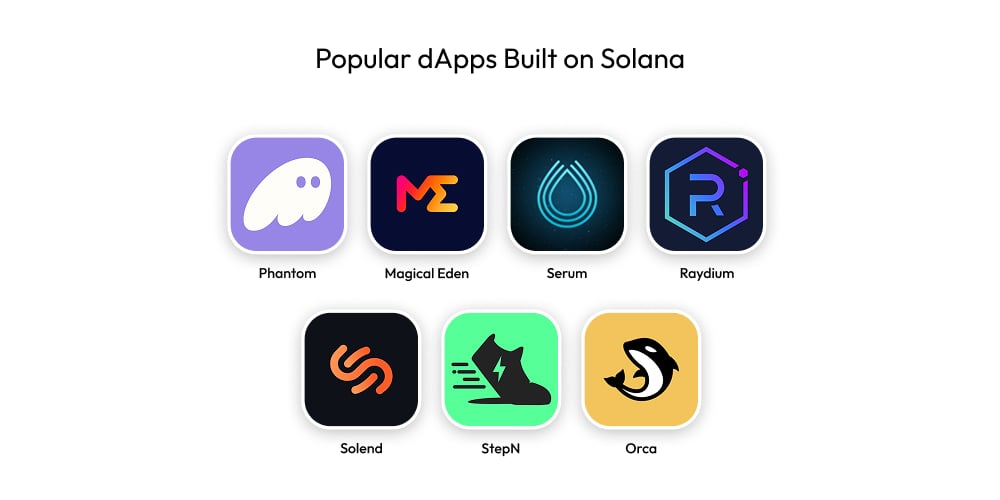
1. Phantom
Phantom is a user-friendly cryptocurrency wallet designed for Solana. It enables users to store, transmit, and trade tokens, as well as connect with decentralized applications such as NFT markets and DeFi platforms.
Phantom, with its slick UI and built-in Web3 browser, has quickly become the preferred wallet among Solana users, due to its rapid speed, minimal fees, and solid security features.
2. Magical Eden
Magic Eden is Solana’s premier NFT marketplace, enabling users to mint, buy, sell, and trade NFTs for extremely minimal costs. It enables a wide range of digital art and collectibles, and includes features such as auctions, creator tools, and launchpad access.
Solana transaction speed and user-friendly design have helped it become one of the most popular NFT platforms in the Solana ecosystem.
3. Serum
Serum is a decentralized exchange (DEX) based on Solana that provides fast, low-cost trading via a completely on-chain order book. It enables cross-chain trading and offers sophisticated functionality akin to centralized exchanges.
Serum, developed by the team behind FTX and Alameda Research, provides a robust DeFi experience while maintaining the performance and transparency that users demand from current cryptocurrency platforms.
4. Raydium
Raydium is an automated market maker (AMM) and liquidity provider on the Solana blockchain development solutions. It connects directly with Serum’s order book, providing users with swap capability as well as the ability to limit orders.
Raydium facilitates yield farming and staking, making it a key player in Solana’s DeFi ecosystem. Its fast transactions and large liquidity pools entice both traders and developers.
5. Solend
Solend is a decentralized lending and borrowing network for Solana. It enables users to deposit cryptocurrency assets and earn interest or borrow against their holdings.
Solend, with its minimal costs and quick transactions, is an economical alternative to traditional financing. It supports numerous tokens, has a rapidly growing user base, and is critical to the expansion of DeFi services on Solana.
6. StepN
StepN is a Solana-based exercise program that pays users with cryptocurrency for walking, jogging, or running. Users buy NFT shoes and earn tokens for their physical activities.
StepN combines lifestyle and blockchain technology through gamification, fitness monitoring, and in-app awards, making it one of the most creative and entertaining dApps in the Web3 area.
7. Orca
Orca is a Solana-based decentralized exchange recognized for its intuitive interface and rapid, low-cost trades. It provides yield farming, token swaps, and liquidity pools for low costs and real-time pricing.
Orca prioritizes ease of use and sustainability, making it suited for both new and seasoned DeFi users. Its community-focused strategy has allowed it to expand swiftly inside Solana’s ecosystem.
Ethereum vs Solana: Coding Comparison
Ethereum Smart Contract (Solidity)
-
- // SPDX-License-Identifier: MIT
pragma solidity ^0.8.0;contract Counter {
uint public count;function inc() public { count++; }
function dec() public { if (count > 0) count–; }
}
- // SPDX-License-Identifier: MIT
Solana Smart Contract (Rust)
-
- use borsh::{BorshDeserialize, BorshSerialize};use solana_program::{entrypoint, entrypoint::ProgramResult, account_info::*, pubkey::Pubkey};#[derive(BorshSerialize, BorshDeserialize)]pub struct Counter { pub count: u32 }entrypoint!(process_instruction);fn process_instruction(_pid: &Pubkey, accs: &[AccountInfo], data: &[u8]) -> ProgramResult {
let acc = &mut accs[0].data.borrow_mut();
let mut ctr = Counter::try_from_slice(&acc)?;
if data[0] == 0 { ctr.count += 1; } else if ctr.count > 0 { ctr.count -= 1; }
ctr.serialize(&mut &mut acc[..])?;
Ok(())
}
- use borsh::{BorshDeserialize, BorshSerialize};use solana_program::{entrypoint, entrypoint::ProgramResult, account_info::*, pubkey::Pubkey};#[derive(BorshSerialize, BorshDeserialize)]pub struct Counter { pub count: u32 }entrypoint!(process_instruction);fn process_instruction(_pid: &Pubkey, accs: &[AccountInfo], data: &[u8]) -> ProgramResult {
Ethereum vs Solana: A Deep Comparison
Explore a deep comparison between Ethereum and Solana, two leading blockchain platforms. Understand their differences in speed, cost, scalability, security, and use cases to choose the best fit for your dApp development needs.
Feature |
Ethereum |
Solana |
| Launch Year | 2015 | 2020 |
| Ethereum and Solana Consensus Mechanism | Proof of Stake (PoS) after the Ethereum 2.0 upgrade (previously Proof of Work) | Proof of History (PoH) combined with Proof of Stake (PoS) |
| Blockchain Transaction Speed | ~15-30 transactions per second (TPS), varies based on network congestion | Up to 65,000+ TPS |
| Block Time | Approximately 12-15 seconds | Approximately 400 milliseconds |
| Transaction Fees | Variable, can be high during congestion; average fees range from a few dollars to tens of dollars | Very low, often less than $0.01 per transaction |
| Smart Contract Language | Solidity, Vyper | Rust, C, C++ |
| Developer Ecosystem | Largest blockchain developer community with extensive tools, libraries, and documentation | Growing rapidly with increasing developer interest, focused on high-performance dApps |
| Network Decentralization | Highly decentralized with thousands of nodes worldwide | More centralized compared to Ethereum; fewer validators, but still secure |
| Ecosystem Maturity | Mature and widely adopted; supports many DeFi, NFT, and enterprise projects | Newer ecosystem but rapidly expanding, especially in gaming, DeFi, and NFTs |
| Scalability Solutions | Layer 2 solutions (Optimistic Rollups, zk-Rollups) and sharding (in development) | Native high scalability with PoH; no need for Layer 2 currently |
| Security | Battle-tested with a strong security track record | Secure but less time-tested; some past network outages have raised concerns |
| Energy Efficiency | Very energy-efficient with PoS upgrade | Energy-efficient due to PoH + PoS consensus |
| Use Cases | Broad: DeFi, NFTs, DAOs, enterprise blockchain, tokenization | Focus on high-speed DeFi, NFTs, gaming, and Web3 lifestyle apps |
| Interoperability | Supports cross-chain bridges and Ethereum Virtual Machine (EVM) compatibility | Growing interoperability with bridges to Ethereum and other blockchains |
| Community & Support | Large, active community, numerous developer grants, and institutional support | Increasing developer incentives and ecosystem funding, but a smaller community than Ethereum |
| Upgrades & Future | Ethereum 2.0 upgrade aims for better scalability, security, and sustainability | Ongoing improvements to network stability and developer tools |
| Best For | Projects needing strong security, decentralization, and broad ecosystem support | Projects needing high throughput, low fees, and fast transaction finality |
Why Choose Solana Over Ethereum?
- Transactions on Solana cost fractions of a cent, making it ideal for microtransactions, unlike Ethereum’s fluctuating and often high gas fees.
- Solana handles over 65,000 transactions per second, significantly outpacing Ethereum’s limited capacity, ensuring smoother user experiences during high demand.
- Solana achieves transaction finality in under one second, reducing wait times compared to Ethereum’s longer confirmation delays during peak activity.
- Solana scales natively at Layer 1 without needing external rollups, avoiding the fragmentation seen in Ethereum’s Layer 2 scaling approach.
- Solana’s Sealevel runtime allows concurrent execution of smart contracts, boosting performance and efficiency in decentralized applications and DeFi platforms.
- Solana invests in mobile tools and devices like the Solana Saga phone, providing crypto-native mobile experiences not yet matched by Ethereum.
Why Choose Ethereum Over Solana?
- Ethereum supports the largest network of dApps, DeFi platforms, and NFT marketplaces, offering unmatched utility and developer engagement across the blockchain development services.
- Ethereum has thousands of validators globally, ensuring greater decentralization, while Solana relies on fewer nodes, increasing centralization risk and control.
- Launched in 2015, Ethereum has a long, proven track record of stability and resilience, unlike Solana’s history of network outages and downtime.
- Ethereum scales through Layer 2 solutions like Arbitrum and Optimism, enabling fast, cheap transactions without compromising the base layer’s security and trust.
- Ethereum is favored by enterprises, governments, and institutional investors due to regulatory transparency, security, and long-standing industry credibility.
- Ethereum offers mature development frameworks and tools like Hardhat and Truffle, making it easier for developers to build, test, and deploy smart contracts.
Conclusion: Ethereum vs Solana
When deciding between Ethereum and Solana for your dApp, it ultimately depends on your project’s priorities. Ethereum offers unmatched security, decentralization, and a mature ecosystem, ideal for long-term, enterprise-level applications.
Solana, on the other hand, provides speed and low fees, making it attractive for consumer-facing apps that require high throughput. Both have their strengths, and choosing the right platform depends on scalability needs, audience, and budget. Partnering with a reliable blockchain development company can help assess the best fit and ensure a successful launch.
Frequently Asked Questions
Q1. What Are The Main Differences Between Ethereum And Solana For Dapp Development?
Ethereum prioritizes decentralization and security with a large developer base and Layer 2 scaling, while Solana offers faster transactions and lower fees through a high-performance, monolithic architecture.
Q2. Is Solana Faster Than Ethereum For Decentralized Applications?
Yes, Solana is faster than Ethereum for decentralized applications, processing over 65,000 transactions per second compared to Ethereum’s ~15–30 TPS, resulting in quicker execution and lower latency for dApps.
Q3. Which Has Lower Transaction Fees, Solana Vs Ethereum?
Solana has significantly lower transaction fees, typically under $0.01 per transaction, whereas Ethereum’s fees vary widely and can reach several dollars during network congestion, making Solana more cost-effective for frequent transactions.
Q4. How Does The dApp Community Support Differ Between Ethereum vs Solana?
Ethereum’s dApp community is larger and more established, offering extensive resources, tutorials, and developer tools for Ethereum and Solana. Solana’s community is rapidly growing, focused on innovation with strong backing, but smaller in Ethereum blockchain comparison.
Q5. Which Blockchain Has Better Developer Tools: Ethereum vs Solana?
Ethereum offers mature developer tools like Hardhat, Truffle, and Remix, with extensive documentation. Solana provides modern frameworks like Anchor but is still growing its tooling ecosystem compared to Ethereum’s long-established support.
